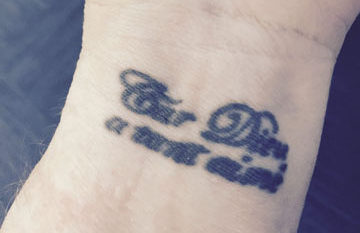
The cradle, cross, and crown are all Chrismons. Chrismons are symbols that represent something about Jesus Christ or the Christian faith. The term Chrismon comes from the Latin phrase “Christi monogramma,” which translates as “monogram of Christ.”
There are many Chrismons. Individually, they remind us of some specific aspect of our God and the relationship we have with Him. Collectively they can tell a story of our faith, all that Christ has done for us, and who we are in Him.
Chrismons on the Covers
 The Got Questions? Reasons Books feature Chrismons on the cover. The first book features an anchor and closes with a chapter that tells how the anchor came to be a Chrismon and how it is a symbol of Jesus, our sure and steadfast hope (Hebrew 6:19). Read: Why the Anchor?
The Got Questions? Reasons Books feature Chrismons on the cover. The first book features an anchor and closes with a chapter that tells how the anchor came to be a Chrismon and how it is a symbol of Jesus, our sure and steadfast hope (Hebrew 6:19). Read: Why the Anchor?
Reasons Book 2 features a fish, drawn in the sand. The final chapter, “About the Fish on the Cover,” addresses Jesus’ calling us to be “fishers of men” (Matthew 4:19). Read: Why the Fish?
Reasons Book 3 features three iconic symbols—a cradle, a cross, and a crown. This book begins with questions focusing on the cradle (Jesus’ birth), followed by a number of questions about the cross, and then the book closes with answers to questions about the crown and glory.
 Together, Chrismons of the cradle, cross, and crown call to remembrance Jesus. Each reveals who He is and important aspects of Him life and ministry. From His incarnation to His sacrificial and substitutionary atoning death, to His resurrected glory, these three Chrismons remind us of the most amazing demonstration of love and the greatest gift of love ever given.
Together, Chrismons of the cradle, cross, and crown call to remembrance Jesus. Each reveals who He is and important aspects of Him life and ministry. From His incarnation to His sacrificial and substitutionary atoning death, to His resurrected glory, these three Chrismons remind us of the most amazing demonstration of love and the greatest gift of love ever given.
The Cradle
John 6:38 For I [Jesus] came down from heaven, not to do mine own will, but the will of him that sent me.
The Cross
John 15:13 Greater love hath no man than this, that a man lay down his life for his friends.
The Crown
John 17:22 And the glory which You gave Me I have given them, that they may be one just as We are one:
Why the Cradle?
Without the Christmas cradle, we wouldn’t have the Calvary cross. God’s love for His children was beautifully displayed when He gave His Son (John 3:16). The prophecy of Isaiah 9:6 foretold that a Son would be given (divinity) and a child would be born (humanity). It was a profound sacrifice when God sent His Son, when Jesus, the Lord of Glory, left Heaven and came to earth to be incarnated in human form, conceived in the womb of a virgin, born in the humblest of circumstances, and laid in a manger for a bed (Gal 4:4). Jesus . He came to live with us.
Matthew 1:23 Behold, a virgin shall be with child, and shall bring forth a son, and they shall call his name Emmanuel, which being interpreted is, God with us.
The cradle reminds us of God’s great love and faithfulness. In the Garden, God promised a Rescuer. With the birth of Jesus, God’s plan began to unfold. Jesus entered into our world a helpless and dependent infant. In His incarnation, Jesus was fully human (a Child was born) and yet fully God (the Son was given). Jesus grew in stature and in wisdom and lived a sinless life ministering through healing and preaching.
Why the Cross?
From the cradle to the cross, Jesus lived the life we could not live. Jesus was tempted, just as we are, and yet He never sinned (Hebrews 4:15). He lived every minute of His life in accordance with the will of the One who sent Him—God the Father, God His Father, God our Father — and then Jesus willingly and purposefully went to the cross. He took upon Himself our sins and paid the price of redeeming us with His own blood.
The emblem of the cross is without a doubt the most important Chrismon. In the cross of Jesus, we see the symbol of our faith, the sorrow of our sins, the sacrifice of our Saviour, the surety of our redemption, and the glory of our souls.
John Stott, in his classic book The Cross of Christ, wrote about the choice of the cross to be the primary symbol of faith in Christ:
Its two bars were already a cosmic symbol from remote antiquity of the axis between heaven and earth. But its choice by Christians had a more specific explanation. They wished to commemorate as central to their understanding of Jesus neither his birth nor his youth, neither his teaching nor his service, neither his resurrection nor his reign, nor his gift of the Spirit, but his death, his crucifixion. The crucifix (that is, a cross to which a figure of Christ is attached) does not appear to have been used before the sixth century.
It seems certain that, at least from the second century onwards, Christians not only drew, painted and engraved the cross as a pictorial symbol of their faith but also made the sign of the cross on themselves or others. One of the first witnesses to this practice was Tertullian, the North African lawyer-theologian who flourished about AD 200. He wrote:
At every forward step and movement, at every going in and out, when we put on our clothes and shoes, when we bathe, when we sit at table, when we light the lamps, on couch, on seat, in all the ordinary actions of daily life, we trace upon the forehead the sign [of the cross].
Most denominations do not teach the practice of tracing a cross on the forehead or the upper body. It is not of necessity since our being “marked” for Christ is not an outward sign. It is an inward sign of the presence and sealing of the Holy Spirit. However, this practice of “marking” a cross was just a visible way that the early church proclaimed identity in Christ. It was meant to show that through the cross of Christ we come to the Light and are marked as His own.
The cross represents both Jesus’ sinless perfection as the perfect, spotless Lamb of God, and His substitutionary atonement when died for our sins. The cross also is a reminder of our sinful nature and our rebellious actions that put Jesus on the cross. So often the question is asked, Who Killed Jesus?
- Some will say the Jews, for Peter proclaimed it (Acts 2:23).
- Some will say the Jewish leaders, for they conspired to kill him (Matthew 26:3-4).
- Still, others will say the Romans, for we know that they were in power at that time.
- We must also remember that it was the purpose, plan, and will of God the Father to commission Jesus with the work of redeeming mankind (Isaiah 53:10).
- And finally, let’s not forget, Jesus went willingly to the cross in complete and total submission to His Father’s will (Matthew 26:42). It was Jesus who laid down His life (Mark 15:37, Luke 23:46, John 19:30).
But who really killed Jesus? The answer is―I killed Jesus…and so did you! It was the sin of man that made the cross of Jesus necessary. It was our sin that put Jesus on the cross, in accordance with the Father’s plan, and by the Son’s obedience to the will of the Father.
Some people (including confused Christians) have said that the cross is a type of execution chair. One misguided Christian even called the cross “cosmic child abuse.” It is neither of those things. The cross is the most beautiful symbol of God’s amazing love and redemptive power. We often think of a heart as the symbol of love, but it should be the cross. A heart can stop loving, and all hearts will one day stop beating, but the cross represents the only One who will never stop loving and in whom is found eternal life.
The cross stands as the central Chrismon of Jesus’ work as Son of God (the cradle), Saviour (the cross), and Conquering King (the crown). We should gaze upon the symbol of the cross and it should take us to our knees in humble adoration of the One who gave His life that we might live.
Why the Crown?
Without the cradle, we would not have the cross. However, even if we had not had the cradle and the cross, Jesus would still be King. Jesus is eternal, meaning He has no beginning or end. Jesus dwelt in glory from eternity past, reigning and ruling as Sovereign over all things. He left glory (the place of glory, Heaven) and came to earth to dwell with us. When Jesus rose from the dead and ascended into glory, He was restored to the place from where He had come—the right hand of the Father (Mark 16:19, Acts 7:55, Romans 8:34, Colossians 3:1, Hebrews 1:3). The crown that represents His glorification after the cross belonged to Him from the beginning of time and from eternity past. It was not received by Him. The crown and glory was fully restored to Him, for He had set it aside when He came to live a human life.
Yes, the crown represents the Lord’s rule and reign as King throughout all eternity and it represents the glory He received when He glorified His Father by completing the mission for which God sent Him (John 17:5), but the crown more fully represents who Jesus is! He is holy, perfect and just, and from Him flows love, joy, peace, patience, kindness, goodness, faithfulness, gentleness, and self-control. He is the Sovereign Ruler over all!
In His perfect, sinless life, in His sacrificial offering of Himself for the sins of man, Jesus magnified His love. God is perfect and holy and He requires the same perfection and holiness from man. (Matt 5:43-45, 48)
It is not just being good that is required to enter into the presence of God. God demands that we be perfect (Matt 5:48). That is something we can never achieve, so God sent Jesus. Jesus came to do for us what we can not do for ourselves: live a life of sinless perfection. And Jesus gives to us His righteousness—the righteousness symbolized by the Crown.
Imputed Righteousness
Imputed righteousness is a doctrine of the Christian faith that should be taught and preached often. After Jesus died on the cross, He descended into the abode of the righteous dead, which was in the “heart of the earth” (Matthew 12:40). When Jesus rose from the grave and ascended into Heaven, He was glorified for not only the payment of sins on the cross but also for the sinless life He had lived on earth. Christ not only died for us, He also lived for us! It is the righteousness of His sinless, perfect life that is imputed (credited) to us in salvation. We are reconciled to God because…
2 Corinthians 5:21 He hath made him to be sin for us, who knew no sin; that we might be made the righteousness of God in him.
Martin Luther called this The Great Exchange. An earlier church father, Athanasius of Alexandria (296-373 AD), called it The Glorious Exchange.
Christ took upon Himself our sins, paid the price for all of them, and when He saved us He washed them away and gave us His righteousness.
Let the Crown of Christ be a symbol that brings to mind our great gift of Christ’s imputed righteousness. The life we did not live, and the righteousness we did not earn—the righteousness that Christ has given to us — perfection in the eyes of God. When God looks at us, He sees the righteousness of Christ in which we are clothed (Isaiah 61:10, Philippians 3:9).
Humble yourself before God. Not only before the cross of His substitutionary sacrifice, but also before the cradle of His incarnation and the crown of His glorification. See the immensity of His life and the majesty of His righteousness. Keep your eyes on Jesus and your heart devoted to Him, remembering all He has done for you and all He has given to you.
The cradle, cross, and crown should always be a reminder of the hope of glory. Our resurrected life began the minute Jesus saved us, but the rewards of our inheritance will be fully received when we enter into His glory.
<*}}}><
Read also: Why the Anchor? and Why the Fish?
*******
Jesus is the Reason this Ministry Exists
At Reasons for Hope* Jesus, we are committed to equipping, encouraging, and empowering Christians to know Jesus better, love Him more, and share their faith. We also reach the lost through our Salvation Page.
With your support, we can continue to provide valuable resources and engaging content. Please join us in our mission by donating today. Your generous contribution helps us expand our outreach of sharing biblical truths and hope in Jesus. Thank you for your kindness and for being an integral part of our mission.
*******
*******
***A Hidden Message in Psalm 23?***
Hidden in the six verses of Psalm 23 are 11 names for Jesus. When you subscribe to our newsletter, we’ll send you The Names of God in Psalm 23 PDF that reveals all 11 names and Scripture verses of comfort and hope (link will be sent in your confirmation email).
 A Room with a View of Eternity—The Last Will & Testament of Jesus Christ Take a seat at the Master's table. Learn about the riches He gives to all who are His. This book will bless and encourage you, give you hope, and help you live in the joy of your salvation and the riches of Christ that are yours.
A Room with a View of Eternity—The Last Will & Testament of Jesus Christ Take a seat at the Master's table. Learn about the riches He gives to all who are His. This book will bless and encourage you, give you hope, and help you live in the joy of your salvation and the riches of Christ that are yours.

The Top Ten Got Questions? in 2023
- The Meaning of NUMBERS in the Bible?
- Was Jesus CRUCIFIED on Wednesday, Thursday, or Friday?
- How was Jesus Like a Worm? What’s the CRIMSON (OR SCARLET) WORM in Psalm 22?
- How are the Shepherd’s ROD and STAFF Different?
- How long did JOB SUFFER?
- What is the Significance of the Wise Men's THREE GIFTS? And were they kings?
- Did The Wise Men Arrive 12 DAYS AFTER JESUS’ BIRTH? Or Was It Much Later?
- Jesus’ Last Days TIMELINE: the Cross and the Resurrection
- The Meaning of COLORS in the Bible?
- Did Jesus Fight Satan to Take Back the KEYS of Death and Hell?
There is much to be learned from those who have gone before us in the faith. Check out our Cloud of Witnesses category that features the words of departed saints who are now with the Lord in glory. Their words equip and encourage us even to this day. Take a few minutes to hear...
- ONLY ONE LIFE, Twill Soon Be Past – by C.T. Studd (1860 – 1931)
- “The Love of God is Greater Far” by Frederick M. Lehman (1917)
- Prayers from Billy Graham
- Who Was Robert Robinson? What’s the Story Behind “Come Thou Fount”
- “Immanuel” — A Poem by Charles Spurgeon (1834-1892)
- Who Am I? A Poem by Deitrich Bonhoeffer (1905-1945)
- Understanding the Everlasting Arms of God, by J.R. Miller (1840–1912)
- 24 Reasons Why I Love America, by John Wayne (1907-1979)
- Give Me Perpetual Broken-heartedness (from The Valley of Vision)
- Abide with Me, by James Smith, 1859
This remains one of our most popular pages viewed.![]()

TOP TEN Videos from Reasons for Hope* Jesus
- Memorial Day BAGPIPES TRIBUTE: Amazing Grace
- RISE AND SHINE and Give God the Glory, Glory!
- WERE YOU THERE When They Crucified My Lord?
- PAUL HARVEY: THE BIRDCAGE
- PRESIDENT RONALD REAGAN: A SOLDIER'S PLEDGE
- Hark! the Herald Angels Sing -- CHARLIE BROWN Christmas
- JOHN WAYNE ~ WHY I LOVE AMERICA
- Jimmy Stewart - Nativity Scene Prayer: Mr. Krueger's Christmas
- THE LEGEND OF THE CANDY CANE - A Christmas Story to Share
- Not by Might, Not by Power, But BY MY SPIRIT says the Lord (Zechariah 4:6)
*****************























